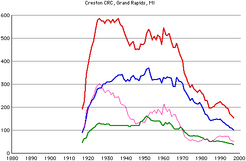History[]
Creston Christian Reformed Church was sponsored by Coldbrook (now Beckwith Hills) CRC northeast of Coldbrook's original location. It organized in 1915.
Historical Details[]
Locations[]
- Page Hall, 1431 Plainfield NE (1915-17)
- Shenahan Hall, 1418 Plainfield NE (1917)
- 238 Spencer Street NE, Grand Rapids, MI 49505 (built 1917)
Pastors[]
- Karst Bergsma, 1916-23
- W. Groen, 1924-26
- Henry Verduin, 1926-46
- W. P Brink, 1948-52
- R. O. De Groot, 1953-59
- W. Hendriksen, 1961-65
- J. W. Uitvlugt, 1966-71
- J. Dykstra, 1972-82
- D. A. Kamper, 1974-78
- Donald J. Van Beek, 1983-present
Daughter Churches[]
- Riverside, 1953
Membership Overview[]
Creston grew steadily until 1925, when it stabilized at about 580 members. A decade of decline began in 1936, and membership hovered around the 500 mark through 1963. Then came a long period of decline, which ended in 1985. The church grew 14% from 1985 to 1991, in part due to the highest birth rate in a long time.
Creston's future looked bleak between 1971 and 1980, with a youth ratio of 19 to 21% - dangerously low. This represents the longest period with a low youth ratio and the lowest youth ratio of any surviving congregation. Things seem to turn around for a while circa 1990. The current youth ratio of 34% is average, and it has been increasing since 1978. This coupled with a high birth rate should overshadow the high death rate.

Membership data, Creston CRC, Grand Rapids, MI
Membership Data[]
Green (lower) line shows membership in families; blue (middle), professing members; red (top), total members; and magenta (thin), non-professing members.

Youth ratio, Creston CRC, Grand Rapids, MI
Youth Ratio[]
Red line shows nonprofessing members as a percentage of total membership.

Five year growth rate, Creston CRC, Grand Rapids, MI
Five Year Growth Rate[]
Red line shows five year growth rate. A five year growth rate between 10% and -10% is considered stable; greater than 10% indicates a growing congregation; one below -10% indicates a church in decline. This makes no allowance for daughter churches.
Data source: Yearbooks of the Christian Reformed Church. Dates are year prior to publication date since data is gathered at the end of one year and published in the next.